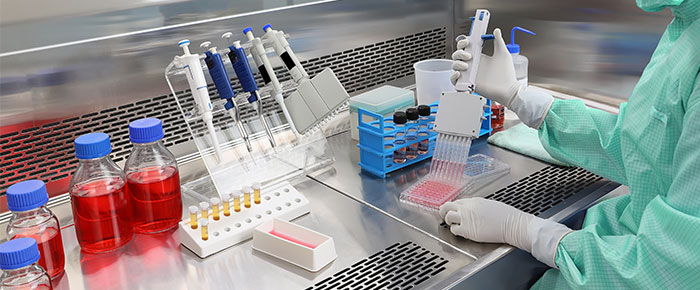
Cell lines are a necessary tool in the arsenal of almost everyone who studies human diseases. Though it remains debatable whether these cell lines accurately represent how cells in vivo respond and operate, they remain an essential model for screening pharmaceuticals, testing new genetic modification techniques, exploring new signaling pathways, and developing new strategies to analyze and target human disorders, from cancer to inflammatory and neurological disorders. It’s, therefore, worth exploring where these commonly used cell lines came from and addressing the legacy they leave behind.
The beginnings of cell culture
Cell culture dates back to the 1800s when Wilhelm Roux was first able to culture chicken embryos using a saline solution for only a few days. It really took off a bit later in the early 1900s, when primary cell culture was first utilized by Ross Granville Harrison, who was able to culture nerve cells from frogs using the hanging drop method. This method typically involves using an inverted watch glass to suspend drops of liquid containing cells instead of spreading them across a petri dish and potentially squishing them. Dr. Harrison would take frog embryonic tissue submerged in lymph solution on cover slides and turn it upside down, where he could observe new fibers develop from the tissue. This technique was not performed under sterile conditions, so while it was a great first start, cell culture didn’t truly become widely adopted until aseptic techniques were introduced, ultimately leading to the development of the first cancer cell lines.1
The first cell line
The name Henrietta Lacks carries a lot of weight when it comes to scientific achievement and controversy. A mother of five and only 31 at the time of her cervical cancer diagnosis, she had undergone radium treatment and had a biopsy of her tumor sent to Dr. George Gey’s lab. Dr. Gey, who had tried and failed to re-grow cervical cancer samples from various patients, soon found that Lack’s tumor cells were capable of continually proliferating. These cells ultimately led to the first widely-used cancer cell line, HeLa. Interestingly, they also helped shed light on the role of human papillomaviruses (HPV) in promoting cervical cancer, having identified HPV 18 as the strain that was responsible for HeLa cells’ ability to rapidly reproduce.2,3
Unfortunately, while the contribution of these cells to biological research as a whole has been immense, some controversy has arisen due to the process by which the cells were obtained. Henrietta Lacks never consented to the use of her cells in biological research, which led to several lawsuits from her family accusing companies of unfairly profiting from the cells.2 Though some of her descendants have called for a reduction in the use of HeLa cells in research, others are now leading a campaign called #HELA100, which hopes to celebrate her life and legacy and bring attention to the incredible role her contributions have made to science over the last 70 years.4
Origins of other important lines
HeLa cells aren’t the only ones with a fascinating story. Another widely used cell line, HEK293, dates back nearly 50 years, when Dr. Frank Graham worked with Dr. Alex van der Eb in the Netherlands, introducing DNA via calcium phosphate transfection. This technique, still widely used today to transfect cells, allowed Dr. Graham to generate a HEK293 cell line expressing Adenovirus 5-transforming genes. He eventually brought the cell line back to Canada and, in collaboration with McMaster University, developed Ad5-based viral vectors for gene transfer protocols and recombinant vaccines.5
Perhaps the most widely used breast cancer cell line ever, MCF-7, dates back to 1973 in a lab run by Dr. Soule at the Michigan Cancer Foundation. These cells were isolated from the pleural effusion, or build-up of fluid between the lungs, of a 69-year-old woman with metastatic disease. This cell line has particular relevance to the discovery of hormone responsiveness in breast cancer; in vitro testing was carried out on the cultured cells when they were first harvested, with the anti-estrogen drug tamoxifen able to inhibit MCF-7 cell growth, an effect that was reversed by adding back estrogen. Though anti-estrogen therapy would be studied in more detail later, the cells represented, at the time, the main building block to showing that estrogen could directly stimulate breast cancer cell growth.6
Though cell lines may not have the standing they once did in the scientific community, they have still played a massive role in furthering research from the bottom up safely and efficiently. New cellular models are continuously being designed to better mimic human disorders compared with cell lines, such as organs on a chip and induced pluripotent stem cells (iPSCs), themselves a new kind of cell line. Without cell lines like HeLa and MCF-7, however, we would never have been able to achieve such lofty heights, and many life-saving treatments would have never been discovered in the first place.
LabTAG by GA International is a leading manufacturer of high-performance specialty labels and a supplier of identification solutions used in research and medical labs as well as healthcare institutions.
References:
- Richter M, et al. From Donor to the Lab: A Fascinating Journey of Primary Cell Lines. Front Cell Dev Biol. 2021;9:711381.
- Science Alert. What Are HeLa Cells? A Cancer Biologist Explains The Controversy That Cannot Die. Available at: https://www.sciencealert.com/expert-explains-how-the-controversial-hela-cells-gained-their-immortality.
- John Hopkins Medicine. The Legacy of Henrietta Lacks. Available at: https://www.hopkinsmedicine.org/henriettalacks/.
- Henrietta Lacks: science must right a historical wrong. Available at: https://www.nature.com/articles/d41586-020-02494-z.
- Government of Canada. Recognizing the scientific impact of Dr. Frank Graham’s HEK 293 cell line.
- Comşa Ş, et al. The Story of MCF-7 Breast Cancer Cell Line: 40 years of Experience in Research. Anticancer Res. 2015;35(6):3147-3154.


